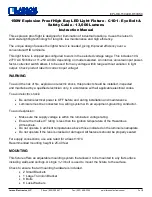
20
situations where there could be several minutes before the arrival of advanced life
support (ALS) personnel. and also can be used on the ambulance and in the
hospital, and so on.
The AED7000 Plus is an automated external defibrillator (AED) that uses
voice prompts and visual indicators to guide the rescuer through a resuscitation
sequence that may include defibrillation and/or cardiopulmonary resuscitation
(CPR). The unit incorporates the Biphasic Truncated exponential Defibrillation
waveform, and operates in either adult or pediatric mode. The AED7000 Plus
supports both adult and pediatric defibrillation electrode pads, and automatically
adjusts the defibrillation energy based on the type of electrode pads connected to
it. Following attachment of electrodes to a victim’s chest, the defibrillator
monitors the electrocardiographic (ECG) rhythm of the victim’s heart, analyzes
that rhythm, and determines whether the rhythm is shockable or non-shockable.
When needed, defibrillation energy is delivered through these same electrodes.
When the unit detects a shockable rhythm, it charges and issues the warning
PRESS FLASHING SHOCK BUTTON
. The rescuer presses the Shock Button to
deliver the shock. The rescuer will then be prompted to perform CPR for a period
of 2 minutes, after which the unit automatically initiates a new ECG analysis.
Indications
Prior to using the AED7000 Plus, the patient should be assessed by a trained
person. If defibrillation with the AED7000 Plus is indicated, all of the following
signs should be present during patient assessment:
• Unconsciousness
• Absence of breathing
• Unresponsiveness (no signs of circulation)
Contraindications
The AED7000 Plus should NOT be used if the patient exhibits any of the
following
signs:
• Patient is conscious
• Patient is breathing
• Patient is responsive (has signs of circulation)
















































